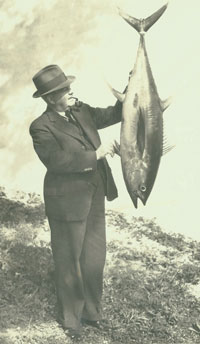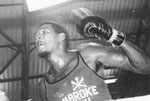

|
This month Bermuda athletes make splash at London Games Photo: Courtesy Bermuda Olympic Association Bermuda made a splash in London at the 1948 Olympics, the first to be held since 1936, and the ensuing outbreak of the Second War War. It was second time Bermuda had competed at the Games and unlike in 1936, the contingent was integrated. There were 12 athletes in all: Phyllis Edness, Phyllis Lightbourn, Hazzard Dill, Perry Johnson, Stanley Lines and Frances Mahoney competed in track and field; swimmers Walter Bardgett, Robert Cook, Philip Tribley, Derek Oatway and Donald Shanks, and diver Francis “Goose” Gosling, who turned in the best performance of all. Bermuda was one of 61 countries represented and its team was the seventh to enter Wembley Stadium for the opening ceremonies on July 29. Dressed in white doeskins and wearing white helmets, they were led by manager W.F. “Chummy” Hayward, carrying the flag. Of the track and field athletes, Phyllis Lightbourn had the best showing. She reached the semi-finals of the 100 and 200 metres and narrowly missed getting into the long jump final. Phyllis Edness was in line to win her100 metre heat, but stomach cramps robbed her of that achievement. The relay team of Dill, Johnson, Lines and Mahoney finished last in the second heat, Dill’s third-place finish in the 400 metres heat was not enough to earn him a place in the second round and the swimmers were eliminated as well. Diver Gosling had an impressive 10th place finish. It’s believed he would have placed as high as sixth had he not been distracted by a photographer’s click which caused him to lose ten points. He didn’t lodge a protest, but the next contestant did, refusing to dive until photographers were removed from the gallery. The Bermuda athletes enjoyed their share of celebrity during their weeks in London. They were sought out for autographs, Lighbourn was a crowd favourite and Gosling’s result put him in the spotlight. But the Bermudians were disappointed by their showing—only Lightbourn, Edness and Gosling came close to matching their previous times. Lighbourn collapsed at the finish line of the 200 metres race and had to be carried off the field. Bernard Brown, The Royal Gazette’s man on the scene, wrote: “They have not said so in so many words but their manner indicates to me that they feel they have let the colony down. Personally I do not think so. The people of Bermuda did not expect them to win medals but did expect them to do their best. I think they exceeded expectations.” Sources: The Royal Gazette, July 14, August 2 and 9. |
|
Olympic stamp of approval The Bermuda Post Office has released a new set of stamps commemorating this month’s Olympics in Beijing. The four stamps feature the natural elements of earth, air, fire and water, which is the theme of the Beijing Games, with each one representing one of four sports—track, swimming, horse riding and sailing. Archaeologists have found two skeletons beneath the floorboards of St. Peter’s Church in St. George’s, The Royal Gazette reported. They believe one of the skeletons is of Sir Jacob Wheate, a British navy captain and commander of the HMS Cerberus, which sank in 1783 and is now a dive site. It’s believed Wheate died of yellow fever, which would indicate why he would have been hurriedly buried beneath the church’s floorboards and not given a funeral that was more in keeping with his standing in society. Further investigation is needed to determine the identity of the second skeleton. Archaeologist Brent Fortenberry said his team had been invited by St. Peter’s rector Rev. David Raths to carry out excavations beneath the church because St. Peter’s is approaching its 400th anniversary and he wanted us to find new stories about the church through archaeology. St. Peter’s Church, which was built of cedar in 1612 and rebuilt from stone in 1713, is said to be the oldest Anglican Church in the New World. Fortenberry and his team have been excavating sites in St. George’s this summer for the Bermuda National Trust. New calls for three-day Cup Match Yet another Cup Match draw has once again led to calls for the game to be played over three days. Thousands poured into Somerset Cricket Club over the two days of the annual Classic to see Somerset battle St. George’s in a rain-delayed match that ended with St. George’s retaining the cup. Newspaper opinion pages and talk shows have been dominated by discussions over who was responsible for the draw along with calls for a three-day Cup Match. Club presidents, Richard Scott of Somerset and Neil Paynter of St. George’s, were lukewarm to the idea. St. George’s caption Lionel Cann said a three-day match would produce a result—with more boring stretches. Cann told the Mid-Ocean News: “If people want three days, give it to them but please accept you are going to have a lot of more boring times in cricket. You can either have a lot more excitement and maybe ending up in a draw or boring cricket with a result.” See our August 2007 home page to learn about the origins of Cup Match. Government’s Department of Culture had captive audiences for a series of events held in July and August to commemorate the emancipation of slaves in Bermuda (and throughout the rest of the British Empire) on August 1, 1834. It kicked off with a dance work ‘A Woman Named Prince’ choreographed by Conchita Ming that was performed at the Rubber Tree in Warwick and included a march celebrating black lodges that wound its way through the streets of Hamilton, stopping at historic sites along the route. The final event, which took place on August 7 at Liberty Theatre, featured a video documentary Scattered Africa: Faces and Voices of the African Diaspora as the offering for the Third Annual Dr. Kenneth Robinson/Cyril Packwood Memorial Lecture. |
|||||||||
| © 2008 Bermuda Biographies All rights reserved |
|||||||||||


